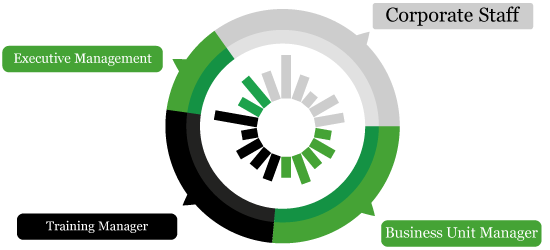Examining eLearning ROI from Different Perspectives
It's a fact that eLearning is an ongoing process that impacts the entire company, not just an independent business unit. Today, more than ever, investing in eLearning is the key for entering the e-business environment.
For this and other reasons, training processes are often evaluated in monetary terms. Thus, different members of the organization: Business Unit Managers, Training Managers, HR Managers, among others, need to measure ROI (Return of Investment).
What is ROI (Return on Investment)?
A measurement that compares the investment in a training deliverable with the eventual cost benefits over a specified period of time. It's composed of two major factors: Benefits and Costs. ROI is therefore a primary tool in the management of learning.
Because each area of the company manages several guidelines, ROI becomes complex and difficult to standardize since each department has their own views about what should be evaluated to determine if there was a return of the investment in the training processes.
Here we provide a brief analysis of different corporate perspectives regarding ROI of eLearning, based on Jay Cross 's article "A Fresh Look at ROI":

Training Manager
ROI comes from the satisfaction of the Business Unit Managers. At this point, it’s not so important saving in the training processes costs, but how investing in training processes impact business metrics. The key is tying training results to business results.
As Jay Cross mentions in his article "ROI will no longer be measured in savings or reduced cost of training", instead, it will be measured by quantitative and evident results caused from the investment in eLearning. Therefore, to achieve these goals it's necessary to focus on high quality instructional design and engaging and interactive learning environments
Business Unit Manager
It's a fact that Business Unit Manager's are usually training's primary sponsors. It becomes crucial that you get to know what they are trying to accomplish so you can talk with them about potential results.
You should ask yourself: What will they accept as persuasive evidence that the eLearning program produced the result they expected? The key is always linking learning to business results.
You should know that measuring ROI of eLearning always starts before the learning process actually takes place. It starts when the Training Process Manager and the Business Unit Manager collaborate and support each other.
A collaborative analysis of the problem will identify the difference between the expected results by the manager and those received. Next, estimate the monetary value obtained by eliminating deficiency and put together some tangible projections from these results.
Along the process, it's important you're by the managers side, answering questions about why experience and knowledge are so important to increase performance. As a result, a measurement of ROI based on performance is being created.
Corporate Staff
 No company or organization has the resources to implement all good ideas, so they must choose where to invest. This is why deep analysis reduces the risk of mistakes in the selection.
No company or organization has the resources to implement all good ideas, so they must choose where to invest. This is why deep analysis reduces the risk of mistakes in the selection.
Traditional accounting recognizes physical entities, while the intangibles such as ideas, skills, experience, motivation, etc… are valued at zero. So how do you we measure ROI of eLearning here?
It is suggested to measure both: the subjective factors and the objective ones, and balance them. A good practice is keeping two sets of "accounting books": one for investors and regulators, and the other to keep track of intangible assets.
Executive Management
Top Executives tend to focus on two aspects: strategy and outsmart the competition. They are realizing that competing successfully requires inspired employees, prepared to make wise decisions on the fly, be able to execute good ideas quickly and be proactive. What today's executives pursue is an environment where people learn faster and better than the competition.
Things have changed, they are now more interested in growth of new markets and innovation than in numbers. They value time more than money. As Jay Cross mentions in his article: "More companies are justifying their e-business ventures not in terms of ROI but in terms of strategic goals. Creating or maintaining a competitive edge was cited most often as the reason for deploying an application."
All these objectives and metrics of the different areas are valid, in fact, they complement each other. We are of the ones that believe that the traditional concept of ROI in eLearning is obsolete; the future is to consolidate the different perspectives to make better decisions.

Source: A Fresh Look at ROI. Jay Cross.









